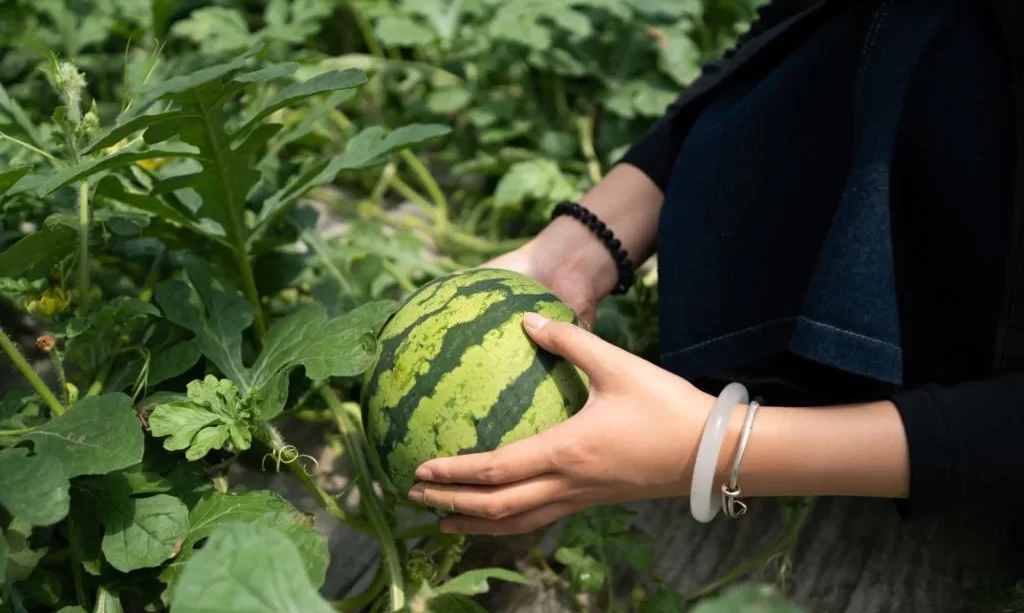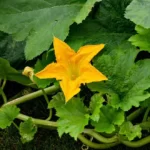Imagine the sheer delight of sinking your teeth into a slice of homegrown, juicy watermelon on a hot summer day. Now, imagine achieving this blissful experience even if you have limited garden space. Container gardening opens up a world of possibilities, and one of the most rewarding endeavors you can undertake is growing watermelon in a pot. In this guide, we’ll explore the art of cultivating these refreshing giants in containers. From selecting the right watermelon variety to choosing the perfect container, we’ll lay the foundation for your sweet watermelon adventure, proving that you don’t need a sprawling garden to enjoy the taste of success.
- 🏅 TRUSTED VARIETY – Popular watermelon seeds used by gardeners for years. It produces beautiful smaller, round watermelons.
- 🍉 DELICIOUS – Although these watermelons are smaller, they pack big, sweet flavor. Very refreshing on a hot summer day.
- ☀️ HEAT LOVING – Watermelons love the heat and will thrive during the hot, summer months.
- 🇺🇸 USA – All of our seeds, including the sugar baby watermelon seeds for planting a home garden, are heirloom, open-pollinated and non-GMO, and grown in the USA. Don’t buy inferior seeds from other countries. This should give you added reassurance that not only can you enjoy the seeds this season, but you can save the seeds each year, adding food security to your home.
- ⚖️ PACKETS – Each sugar baby watermelon seed packet is printed on water-resistant paper, in full color, with growing and harvesting directions included. Each heirloom watermelon seeds packet contains at least 2 grams of seeds (approximately 45+ seeds).
Selecting the Right Watermelon Variety
Growing watermelon in a pot begins with a critical decision: choosing the perfect watermelon variety. Not all watermelons are suited for container gardening, so it’s essential to make an informed choice:
- Compact and Dwarf Varieties: Look for watermelon varieties specifically bred for compact growth. These smaller plants are ideal for containers as they won’t outgrow their allotted space. Compact and dwarf watermelons are designed to thrive in confined environments.
- Consider Your Climate: Your local climate plays a crucial role in determining which watermelon variety to choose. Some varieties are better suited for cooler climates, while others thrive in heat. Research and select a variety that matches your region’s conditions.
- Seedless or Seeded: Decide whether you prefer seedless or seeded watermelons. While seedless varieties are convenient for eating, traditional seeded watermelons may be easier to grow in containers.
Choosing the Perfect Container
The container you select for your watermelon plants can significantly influence their growth and overall success. Here’s what to consider:
- Size and Depth: Watermelons have sprawling vines and deep root systems. Choose a large container with a minimum volume of 5-10 gallons (19-38 liters) to provide ample space for both roots and vines. A depth of 12-18 inches (30-45 cm) is generally suitable.
- Material: Containers made of sturdy materials like plastic, ceramic, or fabric work well for watermelons. Ensure that the container is food-safe if you plan to grow edible watermelons.
- Drainage: Proper drainage is essential to prevent waterlogged soil, which can harm the plants. Select a container with drainage holes at the bottom to allow excess water to escape.
- Stability: Watermelons can become heavy as they grow and bear fruit. Choose a container that can support the weight of the plant and fruit without toppling over.
By carefully selecting the right watermelon variety and choosing a container that meets the plant’s needs, you’ll lay the groundwork for a successful container watermelon garden.
- ✔️PREMIUM MATERIAL: Smirdx plant grow bag is made of premium nonwoven fabric, which is eco-friendly, breathable, reusable, reinforced sewing, durable and easy move. With the plant bags, your plants will grow well in your balconies, decks, porches or patios.
- ☘️PROMOTES PLANT HEALTHY ROWTH:Our plant grow bag provides plants with a ventilated and breathable growth environment, making plant roots more breathable and healthy to grow, excellent drainage eliminating problems with over watering.Looking forward to your harvest.
- 🍅HUMANIZED DESIGNED: Plants will grow above the natural ground level with our fabric garden grow bag, which makes tending your garden much easier as you can weed, prune, water and harvest your crop with less stooping and bending; Ideal for anyone with back or joint problems.
- 🌹WIDE APPLICATION: Our 100 gallon grow bags will provide a stable growing enviroment for your plants, which keep them warm in winter and cool in the summer. And Very great grow bags suit for vegetables and fruits, such as potato, onion, carrot….
- 👍WORRY-FREE SERVICE: 7 x 24 hours after-sales service, if you are not satisfied, 100% refund money. Welcome to Smirdx premium quality and worth price grow bags.
Soil and Growing Conditions
For container-grown watermelons, creating the perfect environment within the pot is essential to support healthy growth:
- Well-Draining Soil: Choose a high-quality potting mix that is well-draining. Watermelons dislike standing water around their roots, so good drainage is crucial to prevent root rot.
- Nutrient-Rich Soil: Mix in compost or well-rotted organic matter to provide essential nutrients. Watermelons are heavy feeders and require a fertile soil mix to thrive.
- pH Level: Aim for a soil pH level between 6.0 and 6.8, slightly acidic to neutral. You can test the soil pH with a simple kit available at garden centers.
- Sunlight: Watermelons are sun-loving plants. Ensure they receive at least 6-8 hours of direct sunlight daily. If you’re growing them on a balcony or patio, place the containers in the sunniest spot available.
- Start planting with the advantage of a complete in-ground garden soil, specially blended to grow bigger, more beautiful plants (versus unfed plants)
- Improves existing soil to build strong roots in annuals and perennials across all your in-ground gardens
- Feeds for up to 3 months with continuous release plant food
- Use with all types of in-ground plants, vegetables, fruits and flowers
- For more spectacular results, start a regular feeding regimen with Miracle-Gro plant food 30 days after planting
Planting and Maintenance
Planting and caring for container-grown watermelons requires attention to detail:
- Planting Depth: When planting watermelon seeds or seedlings, ensure they are placed at the same depth as they were in their original containers. This usually means about one inch (2.5 cm) deep for seeds.
- Spacing: If growing more than one watermelon plant in a large container, space them at least 2-3 feet (61-91 cm) apart to prevent overcrowding.
- Watering: Keep the soil consistently moist but not waterlogged. Container-grown plants may need more frequent watering, especially in hot weather. Water at the base of the plant to avoid wetting the leaves, which can lead to disease.
- Fertilizing: Watermelons benefit from regular feeding. Use a balanced, slow-release fertilizer or apply a water-soluble fertilizer according to the package instructions. Start fertilizing when the plants begin to vine and continue throughout the growing season.
- Support and Pruning: As your watermelon vines grow, provide support for the developing fruit using slings or hammocks to prevent damage to the vines. Prune away excess foliage to improve air circulation and sunlight penetration to the developing fruit.
- Package contains 4 pounds organic vegetable and tomato fertilizer grains and is produced to avoid wasteful runoff, mess, hazards and smells
- Plant fertilizer is formulated with a 2-5-3 NPK to provide vegetables and tomatoes the nutrients they need to create high yield and vibrant foliage
- Jobe’s organic fertilizer contains no synthetic chemicals and are OMRI listed for organic gardening by the USDA
- Application is simple and should be done every 4-6 weeks or as needed during the growing season
- Jobe’s organic fertilizer is easily measured to provide the right amount of nutrients for vegetable and tomato plants without risk of over fertilizing
Pollination and Fruit Set
One crucial aspect of growing watermelons is ensuring successful pollination and fruit development:
- Natural Pollinators: Watermelons rely on pollinators like bees to transfer pollen from male to female flowers. If you have limited access to natural pollinators, consider planting pollinator-friendly flowers nearby to attract them.
- Hand-Pollination: To increase your chances of successful fruit set, you can also hand-pollinate watermelon flowers. Use a small paintbrush or cotton swab to transfer pollen from male flowers to female flowers.
- Female Flowers: Female watermelon flowers are distinguishable by the tiny fruit at their base. Male flowers have a straight stem without fruit. Focus your pollination efforts on female flowers to ensure fruit development.
By tending to the soil and growing conditions, planting and maintaining your watermelon plants with care, and facilitating pollination, you’ll set the stage for healthy growth and the promise of delicious homegrown watermelons in your container garden.
Overcoming Container Challenges
Container gardening, while rewarding, can present unique challenges when growing watermelons. Here’s how to overcome them:
- Space Management: Watermelons have sprawling vines, so it’s essential to provide ample room. If space is limited, consider training the vines vertically using trellises or supports to maximize vertical space.
- Watering Care: Containers can dry out quickly, especially in hot weather. Use mulch to retain moisture and water consistently to prevent stress on the plants. Self-watering containers can also be a helpful solution.
- Fertilization: Container-grown watermelons rely on you for nutrients. Monitor the plant’s growth and adjust your fertilization schedule as needed to ensure they receive sufficient nutrients throughout the growing season.
- Temperature Control: Containers can be prone to temperature fluctuations. Protect your watermelon plants from extreme heat by providing shade during scorching days and moving them to a sheltered spot during cold snaps.
Harvesting Your Container Watermelons
The culmination of your container watermelon growing journey is the eagerly awaited harvest:
- Ripeness Signs: To determine when to harvest, look for signs of ripeness. The skin should become dull, the underside of the melon should change color, and it should sound hollow when tapped.
- Cutting Technique: Use clean, sharp shears or a knife to cut the stem of the watermelon, leaving a small portion attached to the fruit. Be gentle to avoid damaging the fruit.
- Enjoying the Fruits of Your Labor: Once harvested, savor the sweet rewards of your container watermelons. Slice them into refreshing wedges, blend them into smoothies, or use them in creative recipes.
Conclusion
Growing watermelons in containers is a rewarding and accessible endeavor for gardeners with limited space. By carefully selecting the right variety, choosing suitable containers, and providing the ideal growing conditions, you can nurture these luscious fruits to maturity. Throughout the growing season, attentive care, pollination support, and overcoming container gardening challenges contribute to the success of your watermelon plants.
As you enjoy the sweet taste of your homegrown watermelons, you’ll find that the effort and patience invested in container gardening have yielded delicious and satisfying results. So, whether you’re tending to a balcony, patio, or small garden, container-grown watermelons prove that big flavors can thrive in compact spaces, bringing the joys of summer to your doorstep.







